Introduction
The Land Acquisition Act of 2013 represents a pivotal legislative framework aimed at balancing the requirements of infrastructure development with the protection of landowners' rights. This article delves into the multifaceted objectives and key features of the Act, including the significance of fair compensation, transparency in the acquisition process, and the critical role of Social Impact Assessments (SIA). Additionally, it addresses the comprehensive provisions for the rehabilitation and resettlement of displaced individuals, illustrating how these measures contribute to social cohesion and well-being.
The intricate process of land acquisition under the Act is explored, highlighting the various stages from notification of intent to the issuance of the acquisition order. Challenges in implementing the Act, such as bureaucratic delays and resistance from landowners, are examined, alongside potential solutions to enhance administrative efficiency and community engagement. Furthermore, the article discusses recent amendments to the Act, their implications for expedited acquisition processes, and the balance between development needs and landowner rights.
Lastly, the practical implications of the Act for both landowners and buyers are scrutinized, emphasizing the importance of understanding rights and regulatory requirements to safeguard interests and secure investments. Through a detailed analysis, this article aims to provide a comprehensive understanding of the Land Acquisition Act of 2013 and its impact on land acquisition practices in India.
Objectives of the Land Acquisition Act 2013
The Land Acquisition Act of 2013 aims to streamline the land acquisition procedure for public purposes while ensuring fair compensation and rehabilitation for affected parties. The primary objectives of the Act include protecting the rights of property holders, facilitating infrastructure development, and promoting transparency in the acquisition process. One notable example is the case where the Jammu and Kashmir and Ladakh High Court ordered the state to compensate individuals whose property was arbitrarily seized 45 years ago, emphasizing that the right to property remains a legal and constitutional right.
The Act aims to tackle problems similar to those seen in the Noida International Airport project, where the administration had to obtain 1,363.45 hectares of territory, impacting approximately 3,800 families. This emphasizes the significance of equitable compensation and rehabilitation for impacted property owners. As stated in the 2023 Land Gap Report, authorities have committed one billion hectares of land for carbon removal initiatives, illustrating the necessity for transparent and equitable land acquisition methods to achieve environmental objectives.
Furthermore, the Act aims to prevent situations where projects are delayed due to disputes over compensation, as seen in the prolonged legal battles faced by property holders in Srinagar. By mandating fair compensation and transparent processes, the Act supports infrastructure investments and ensures that property owners are not deprived of their assets without due process, thereby fostering a more equitable environment for development projects.
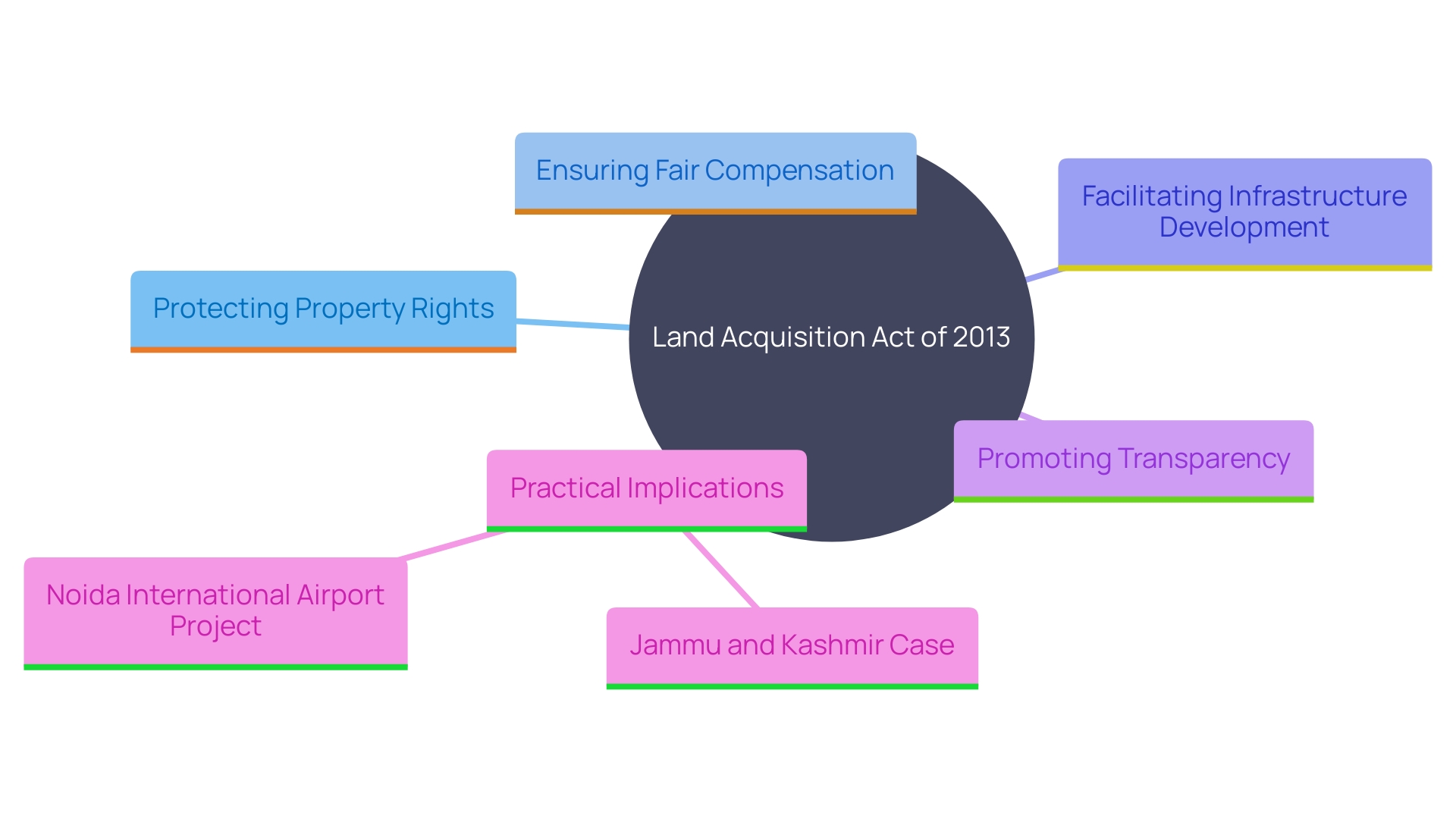
Key Features of the Land Acquisition Act 2013
The Act introduces several key features designed to balance development needs with the rights and welfare of property owners. One prominent feature is the requirement for Social Impact Assessments (SIA), which serve as a methodological tool for evaluating the social sustainability contributions of development projects. This approach, as demonstrated in various studies including the Scapa Flow landscape heritage scheme in Scotland, ensures that the social impacts of participation are analyzed and addressed effectively.
Alongside SIAs, the Act creates a strong compensation system to guarantee that property holders receive just reimbursement for their property. Research shows that just and fair compensation is essential for minimizing conflicts and competing claims over territory, as demonstrated by the LAND-at-scale program, which aims to improve tenure security and access to property.
Moreover, the Act includes provisions for the rehabilitation and resettlement of displaced individuals, addressing the critical need for social cohesion and well-being in affected communities. Studies show that displaced populations, when supported through effective rehabilitation programs, experience improved mental and physical well-being, increased access to essential services, and enhanced livelihood opportunities.
In summary, these features collectively contribute to a more balanced and socially responsible approach to property acquisition, ensuring that the rights and welfare of property holders are protected while facilitating sustainable development.
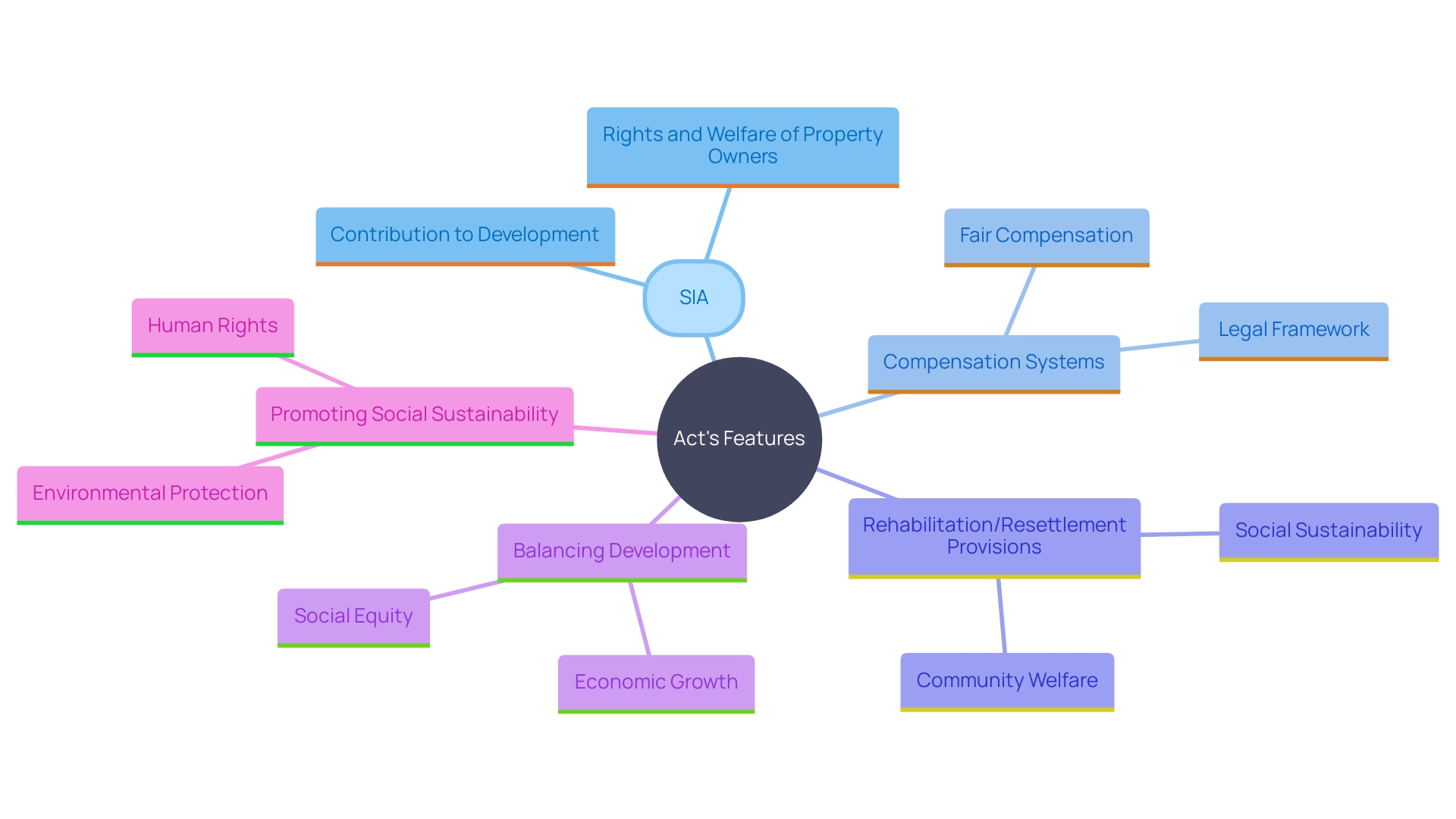
Right to Fair Compensation
A fundamental principle of the Act is the right to fair compensation. This guarantees property holders obtain reimbursement that represents the market value of their property, along with extra amounts to consider the economic and social effects of relocation. For instance, the city of Fort Worth has used eminent domain multiple times since 2020 for projects such as the Lake Arlington Lift Station. This project, aimed at pumping sewage more efficiently, required the city to ensure that displaced landowners were fairly compensated. Despite the city's rapid growth and the $850 million allocated for infrastructure over the past decade, obtaining property remains a significant challenge. Former city council member Cary Moon emphasized that while funding for new projects is available, obtaining the required property is often more complicated. This provision aims to ensure that property owners are not disadvantaged by the acquisition procedure, reflecting broader efforts to balance developmental needs and individual rights.
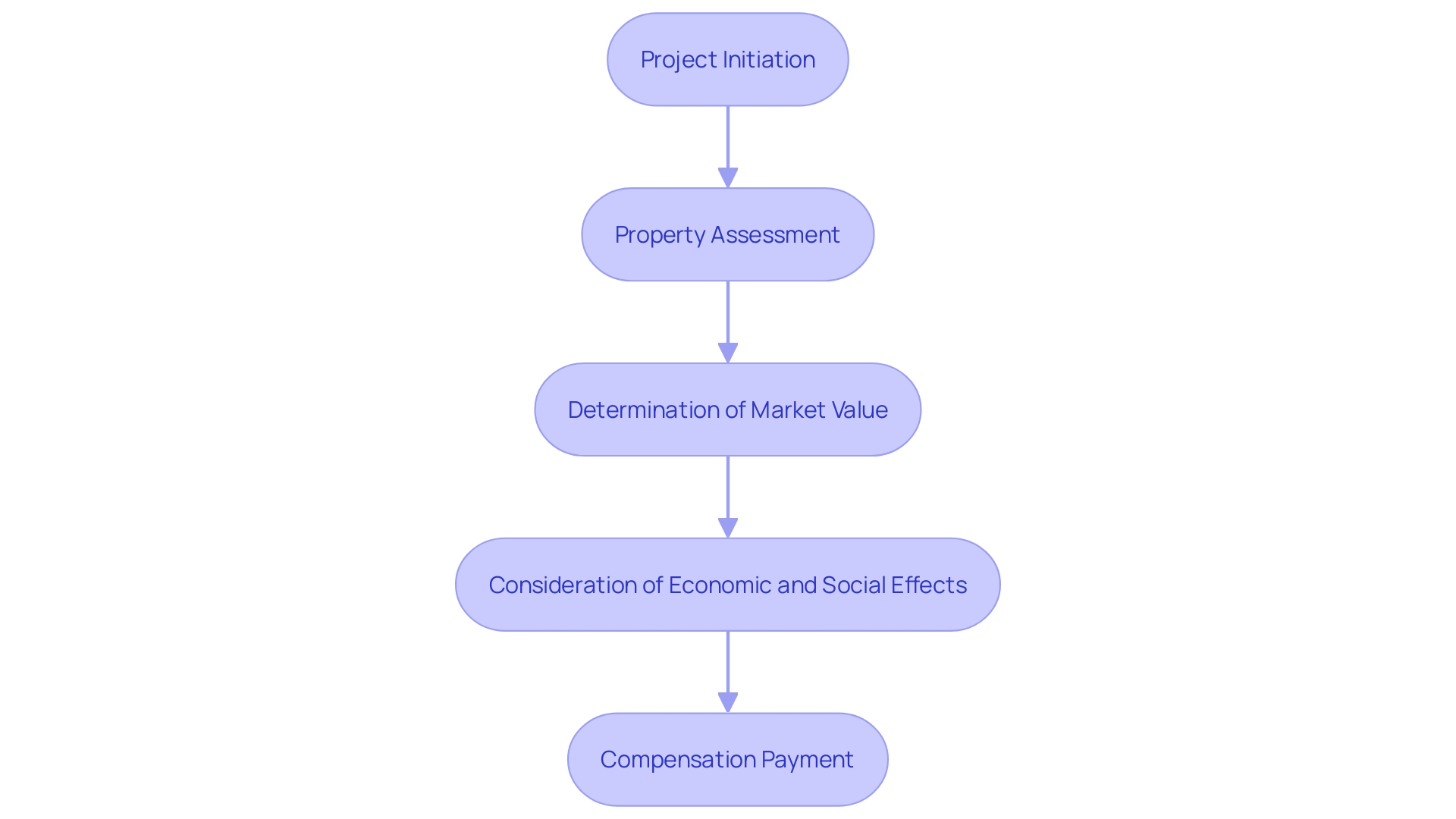
Transparency in Land Acquisition
The Act mandates transparency in the acquisition process by requiring public consultations and disclosures about the intended use of the acquired property. This approach is critical for fostering trust between authorities and landowners, as it helps to reduce disputes and encourage cooperation. The government has acknowledged the necessity for improved transparency, especially in situations where property ownership involves trusts. During the passage of the ECCTA 2023, significant attention was given to trust transparency, with Parliamentarians advocating for improved access to trust information. This led to the government committing to consultations aimed at increasing transparency of trust information. By requiring public consultations and making ownership details accessible, authorities can ensure that stakeholders are well-informed and can participate meaningfully in the decision-making process. This is particularly crucial for large-scale infrastructure initiatives, which frequently depend on clear and trustworthy property information to secure investments and tackle tenure concerns. Open access to terrain data not only supports better decision-making but also aids in providing essential property-related services efficiently.
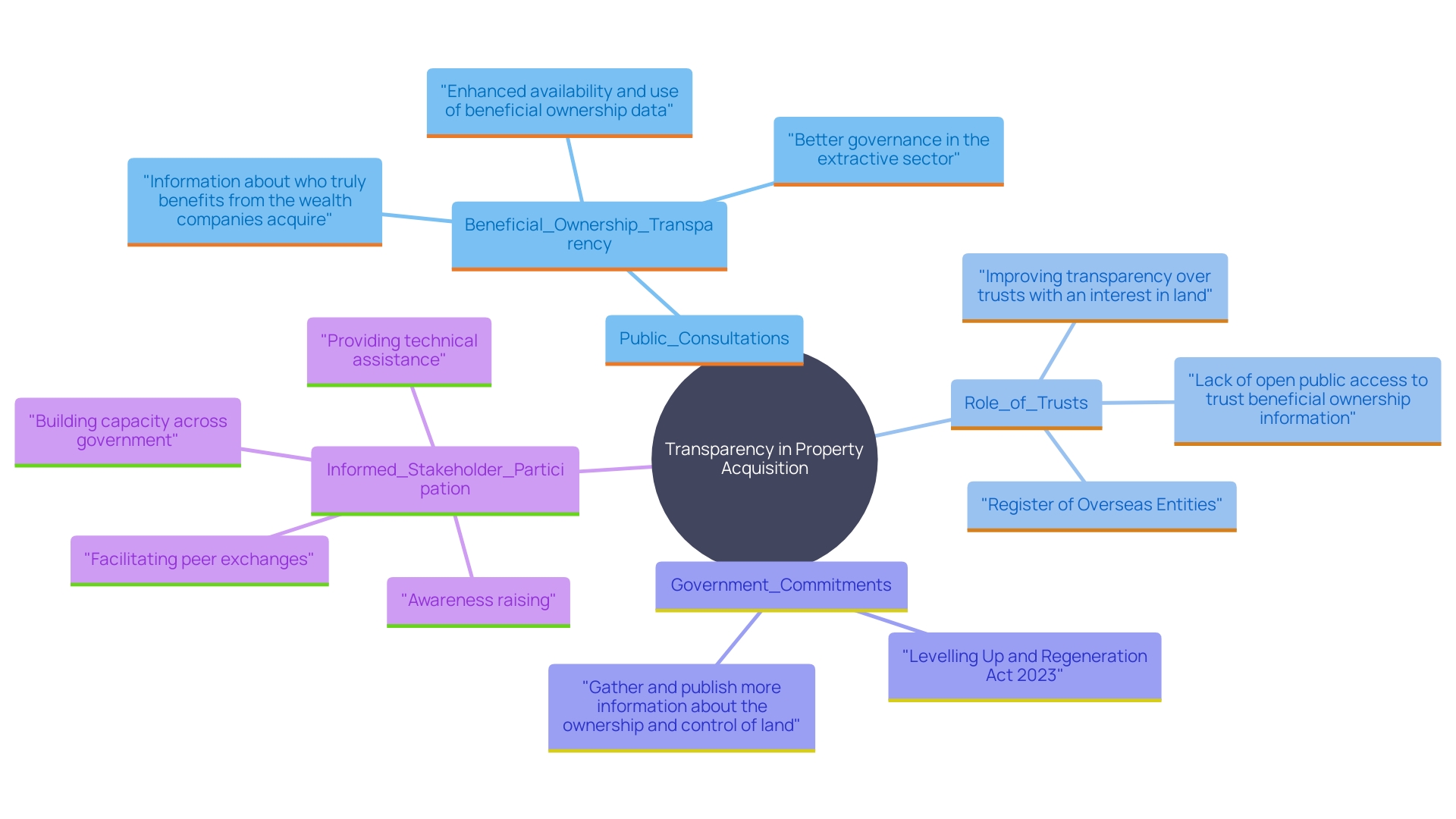
Social Impact Assessment (SIA) Requirement
A key provision of the Act is the mandate for a comprehensive Social Impact Assessment (SIA) before proceeding with any land acquisition. This assessment plays a crucial role in evaluating the potential social consequences of the proposed project, focusing on how it will affect local communities. It involves a thorough analysis of various social sustainability aspects, such as community well-being, social capital, and the sense of place. By incorporating stakeholders' perceptions and employing a context-relevant, bottom-up approach, the SIA identifies both positive and negative impacts, providing a nuanced understanding of the project's social footprint.
The necessity for a Social Impact Assessment guarantees that the perspectives of all impacted groups are taken into account, encouraging increased community involvement in the decision-making. This participatory approach is essential for achieving social relevance and can enhance the overall benefits of the project. For instance, a study of the Scapa Flow landscape heritage scheme in Orkney Islands, Scotland, demonstrated how integrating heritage value assessment with social impact identification can lead to more effective and inclusive project evaluations.
Moreover, the SIA process also helps in identifying measures to mitigate adverse effects on local communities. This proactive strategy not only tackles potential conflicts but also aligns with broader objectives such as tenure security, equitable access to resources, and sustainable use of territory. Such assessments are pivotal in ensuring that development projects contribute positively to the social fabric of the areas they impact, ultimately leading to more resilient and cohesive communities.
Rehabilitation and Resettlement Provisions
The Act encompasses extensive measures for the rehabilitation and resettlement of displaced individuals, ensuring they receive the necessary support to rebuild their lives. These measures include financial assistance, housing, and access to employment opportunities. For instance, following Typhoon Morakot, the government collaborated with NGOs to provide free permanent housing, significantly alleviating the financial burden of housing recovery for affected communities. This policy aimed to facilitate the relocation of Indigenous populations, although it also posed numerous cultural, social, and economic challenges due to their deep-rooted connection to their territory.
Globally, over 114 million people have been forcibly displaced, with one-third being refugees. The Canadian government has been proactive in addressing this humanitarian crisis by offering protection and creating opportunities for resettlement through skills-based pathways. Similarly, in response to the displacement caused by conflicts in Sudan and the Democratic Republic of Congo, international efforts focus on providing comprehensive support to maintain the life, livelihood, and dignity of displaced individuals, especially those with diverse characteristics.
Unconditional cash transfers have been proven effective in improving the well-being of displaced populations, as evidenced by studies showing that such assistance helps meet basic needs and enhances access to healthcare and education. This approach also supports displaced adults in seeking better employment opportunities, ultimately fostering greater social cohesion between displaced and host communities.

Process of Land Acquisition Under the Act
The property acquisition procedure under the Act includes several essential phases aimed at balancing the rights of property holders with the necessity for infrastructure advancement. At first, a notification of intent is issued, which signals the beginning of the acquisition procedure and invites public consultation. This stage is essential for incorporating the views and concerns of local communities and stakeholders.
Following the public consultation, a Social Impact Assessment (SIA) is conducted to evaluate the potential effects of the acquisition on the affected population. This assessment includes not only environmental considerations but also socioeconomic impacts, ensuring a comprehensive understanding of the implications for local communities.
Compensation determination is the next stage, where fair and equitable compensation for landowners is calculated. This procedure often entails resolving title disputes and litigation over compensation values, which can be time-consuming but is crucial for maintaining trust and fairness.
Finally, the acquisition order is issued, marking the completion of the process. Throughout these stages, collaboration between private sector entities, government agencies, and local communities is vital. Such partnerships help tackle property tenure issues and ensure the involvement of local communities, as evidenced by successful participatory property registration programs.
In large-scale projects, preliminary determinations based on non-environmental considerations may also be made, and certificates are issued by commission order. This collaborative method not only enables smoother acquisitions but also empowers governments and investors to capitalize on the value of property assets for further development and investment.
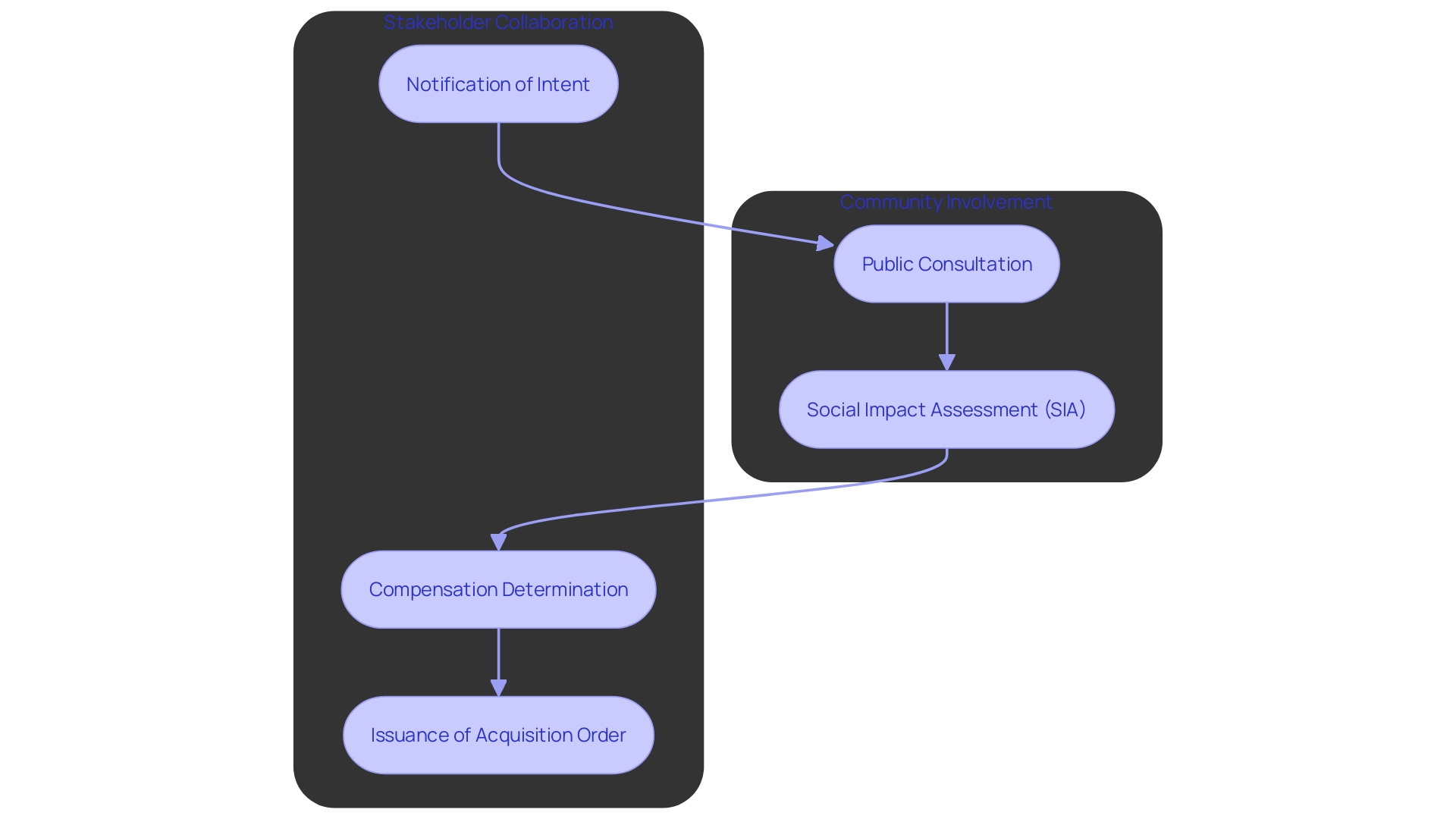
Challenges and Solutions in Implementing the Act
Implementing the Land Acquisition Act involves navigating several significant challenges, including bureaucratic delays, resistance from landowners, and inadequate funding for compensation. 'Bureaucratic delays often arise from the complex and varied property entitlement processes across different jurisdictions.'. According to research on Virginia’s land entitlement system, procedures vary widely, creating challenges for timely decision-making and project progression.
Resistance from landowners is another critical hurdle. For instance, infrastructure investments frequently resort to compulsory acquisition to prevent individual owners from blocking projects by refusing to sell. This procedure, however, can be lengthy and complicated by title disputes or litigation over compensation values.
In terms of funding, the cost of climate change adaptation in developing countries alone is estimated to reach up to $390 billion this decade, far surpassing the current investment range of $20–25 billion per year. Public funds alone are insufficient to cover this gap, highlighting the need for increased private financing.
To tackle these challenges, solutions involve improving administrative efficiency, which can be accomplished by optimizing management systems to offer thorough records and mapping of government properties. This improvement can facilitate timely and clear decisions and reduce delays caused by bureaucratic procedures.
Improving community engagement is also vital. 'Collaboration and partnerships between the private sector, government agencies, and local communities can help identify suitable areas for development, address tenure issues, and ensure the participation of local communities in decision-making processes through participatory registration programs.'.
Lastly, securing financial resources is crucial. Utilizing the worth of property as collateral can attract investment capital, while improved access to state and public areas can enable, finance, and locate infrastructure investments. Investing in modernized land administration systems, which provide certainty about land and property rights, can further enhance the attractiveness of land for development projects.
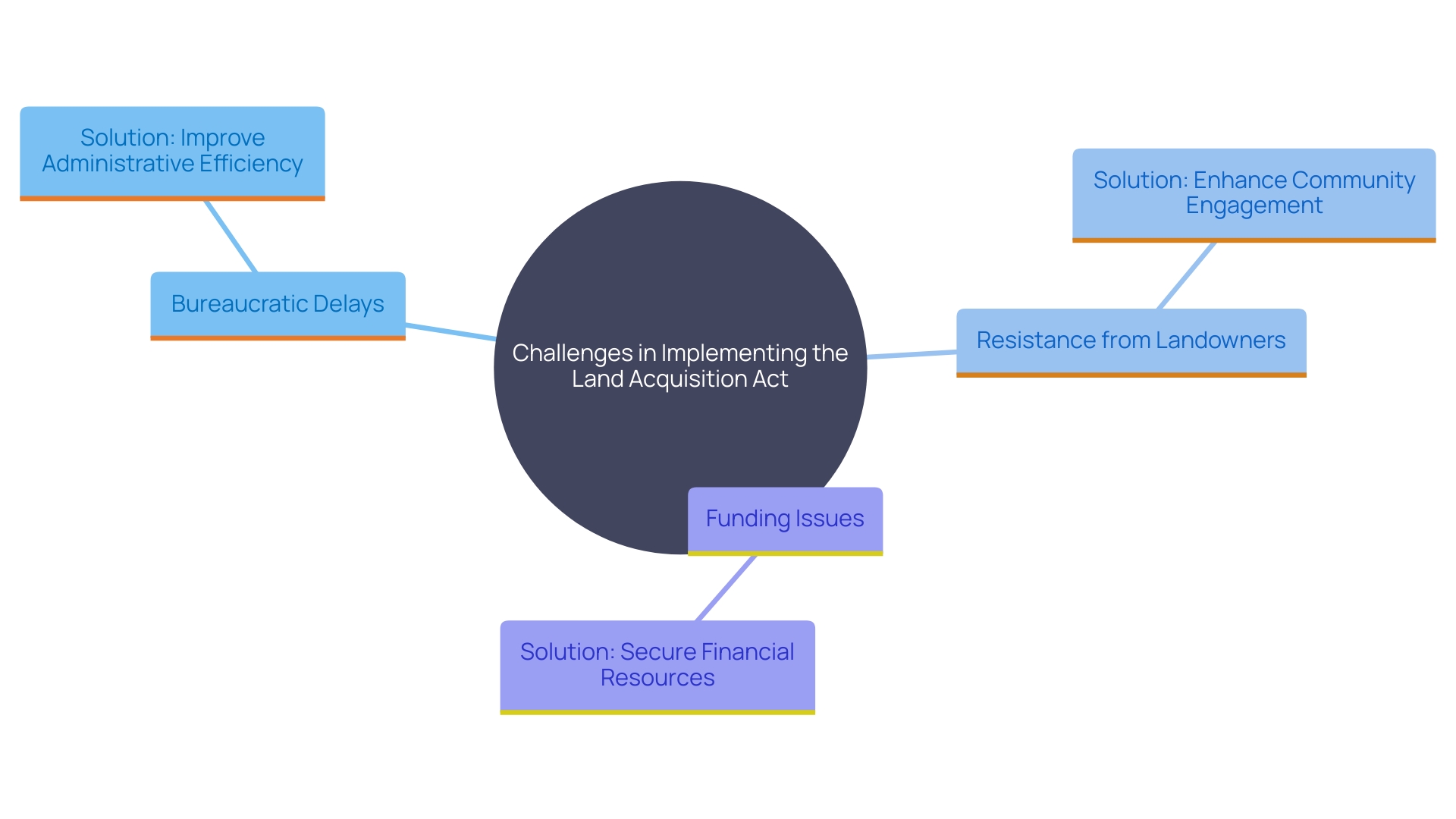
Recent Amendments and Their Implications
Recent amendments to the Act have introduced significant changes aimed at speeding up the acquisition procedure and addressing concerns from various stakeholders. One of the key modifications includes the introduction of permitted development rights, which provide flexibility and planning freedoms to businesses, local authorities, and communities. These rights, effective from 21 May, allow for the conversion of agricultural buildings to a wider range of commercial uses without the need for a planning application. This change is designed to support growth and incentivize different types of development by providing certainty and reducing administrative burdens.
However, the balance between development needs and property owner rights remains a critical consideration. The amendments require careful evaluation of long-term implications, particularly in light of the prior approval requirements from local planning authorities. For instance, converting agricultural buildings to homes or commercial uses still necessitates prior approval for specific issues such as transport and flooding risks.
Furthermore, the amendments to the Act have been influenced by extensive public and expert consultations. The amendments incorporated the opinions of agencies, organizations, experts, scientists, and over 12 million public opinions. This comprehensive approach ensures that the changes address the diverse concerns of various stakeholders, from local communities to the business sector.
In summary, while the recent amendments aim to streamline the land acquisition process and promote development, they also necessitate a careful balance to ensure that the rights of property owners are not compromised. Continuous monitoring and adjustments by relevant authorities will be essential to achieve the intended outcomes and address any emerging challenges.
Practical Implications of the 2013 Act for Landowners and Buyers
The provisions of the Act have profound implications for both property owners and buyers, making it essential to grasp the intricate details of rights and compensation entitlements. For landowners, knowledge of these rights is vital to safeguard their interests during negotiations. The Bahati Properties Ltd case underscored the significance of understanding property rights, as the Supreme Court's decisions directly impacted the applicants' property claims, highlighting broader public interest concerns.
Purchasers, conversely, must navigate a complex legal landscape to ensure compliance and secure property for development. For instance, the Lao government's recent mandate on licensing for commercial property use emphasizes the necessity for buyers to be well-versed in regulatory requirements. The directive, effective since May 10, 2023, mandates that all land-related businesses obtain the requisite licenses, aiming to regulate the sector and ensure tax compliance.
The historical context of territory disputes, as seen in Cambodia, further illustrates the complexities involved. Since the late 1990s, land grabbing has affected hundreds of thousands, with over 830,000 people impacted by disputes involving the government. This underscores the need for buyers to be meticulous in their legal due diligence to avoid potential conflicts and secure their investments effectively.
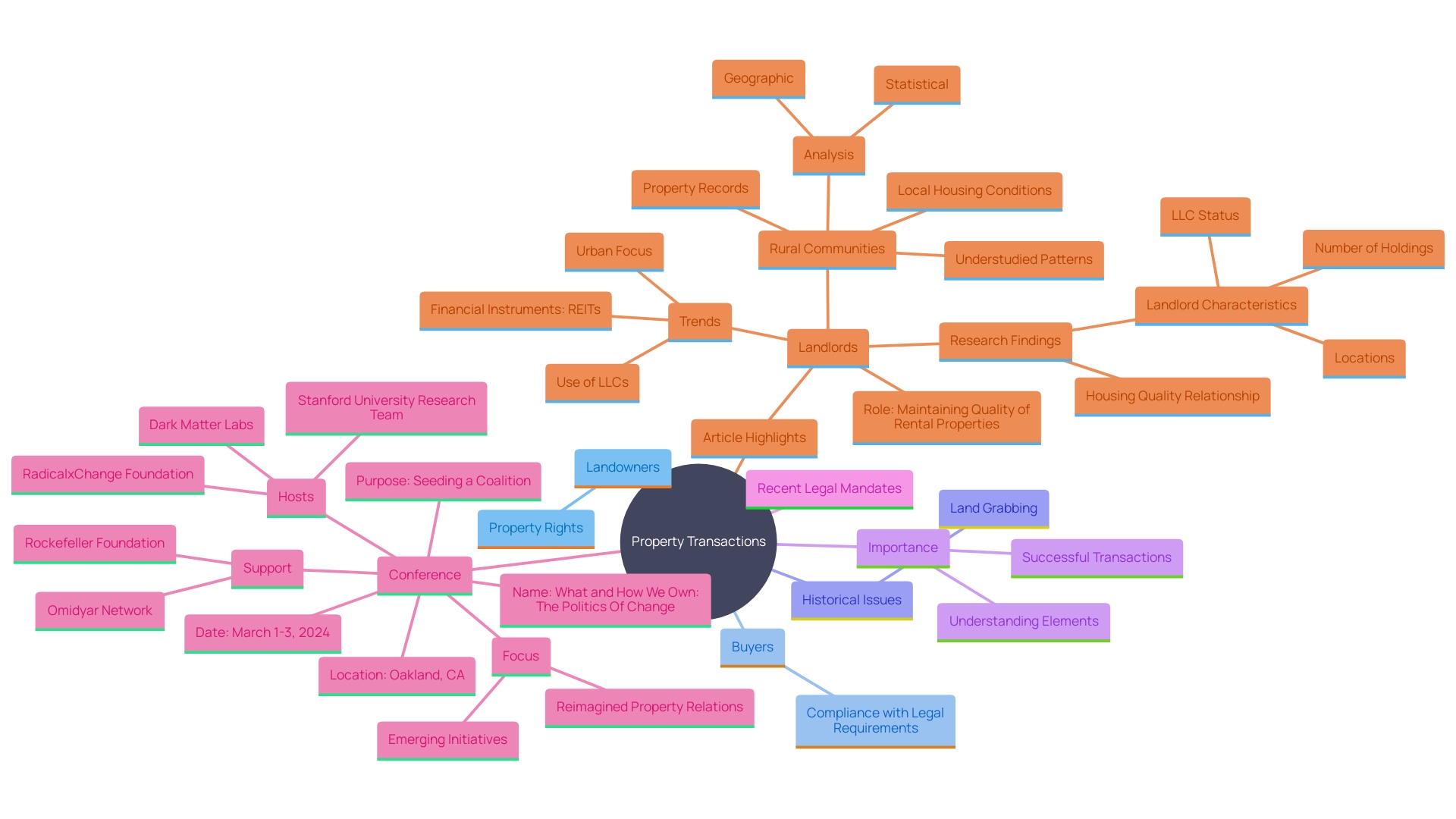
Conclusion
The Land Acquisition Act of 2013 serves as a crucial framework for balancing the need for infrastructure development with the protection of landowners' rights. Key objectives of the Act include ensuring fair compensation, enhancing transparency in the acquisition process, and emphasizing the importance of Social Impact Assessments (SIA). These elements are designed to foster a collaborative environment between authorities and landowners, ultimately supporting sustainable development while safeguarding individual rights.
The Act's provisions for rehabilitation and resettlement of displaced individuals highlight the commitment to social equity and community well-being. By focusing on fair compensation that reflects market value and addresses the socio-economic impacts of displacement, the Act aims to minimize conflicts and foster trust among stakeholders. Additionally, the requirement for SIAs ensures that the social implications of land acquisition are thoroughly evaluated, promoting greater community participation and enhancing project outcomes.
Despite its comprehensive framework, the implementation of the Act faces challenges such as bureaucratic delays and resistance from landowners. Addressing these issues through streamlined administrative processes and improved community engagement is essential for the Act to fulfill its objectives effectively. Recent amendments also introduce flexibility in the acquisition process, necessitating ongoing evaluation to ensure that landowner rights are maintained while facilitating development.
Understanding the practical implications of the Act is vital for both landowners and buyers. Knowledge of rights and regulatory requirements can help landowners safeguard their interests, while buyers must navigate a complex legal landscape to ensure compliance and secure land for development. Overall, the Land Acquisition Act of 2013 represents a significant step toward equitable land acquisition practices that prioritize both development needs and the rights of individuals.




